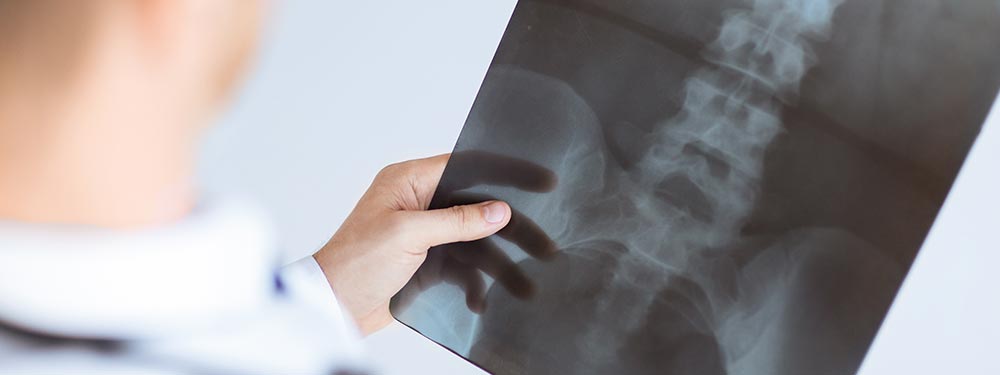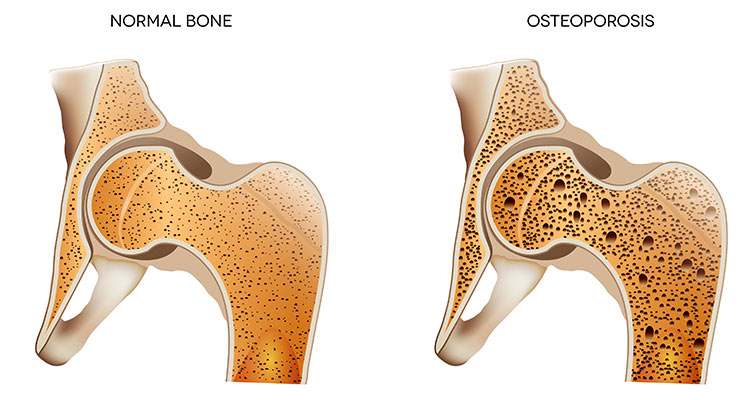Osteoporosis is a condition that causes the bones to become thinner and more fragile over time, leading to a higher risk for bone fractures.
There are two types of bone tissue. One makes up the hard outer “shell” of your bones. The other is inside the bones and looks like a web. This web is made of protein called collagen and minerals, including calcium. Normally, the web is made of many thick strands and is quite dense.
The body constantly breaks down old bones and replaces it with new bone – a process called remodeling. During the first 20 years of life, the body builds new bones more quickly than it removes old bone. We reach our highest bone density in early adulthood – around age 20 or 25. After that, bone mass tends to decline.
Osteoporosis occurs when the body loses more bone tissue than it replaces. That inner bone tissue becomes thinner and weaker. Bones become less dense and lose strength, and are more likely to break easily.
Symptoms of Osteoporosis
There typically are no symptoms in the early stages of bone loss. But once bones have been weakened by osteoporosis, you may have signs and symptoms that include:
- Back pain, caused by a fractured or collapsed vertebra
- Loss of height over time
- A stooped posture
- A bone fracture that occurs much more easily than expected
Diagnosis of Osteoporosis
During a physical exam, you doctor may find that you have lost some height. Or they may notice that the spine of your upper back is starting to curve. Another sign of Osteoporosis is a “fragility fracture,” which is a bone that breaks from a minor injury or during a routine movement.
A bone density test can confirm an Osteoporosis diagnosis. There are several ways to measure bone density:
- DEXA (duel-energy x-ray absoptiometry
- Ultrasound of the heel bone
- Blood and urine tests
Treatment of Osteoporosis
Treatment can slow bone loss and help prevent fractures. The outlook for people with Osteoporosis is good, especially when the problem is caught and treated early. Bone density, even in severe Osteoporosis, generally can be stabilized or improved. Treatment greatly lowers the risk of breaking a bone.
Often the first step in treating Osteoporosis involves nutrition, exercise, and treating underlying conditions. For example:
- Getting enough calcium daily through diet and supplements
- Taking vitamin D supplements
- Performing weight-bearing exercises
- Addressing risk factors such as underlying illnesses, smoking, and alcohol use
- Medications
Prevention of Osteoporosis
Osteoporosis prevention begins in childhood. Find out what you and your children can do to reduce your risks. From childhood through adulthood, regular exercise is vital to building and maintaining good bone health.
It’s never too early or too late to take steps to protect your bones from osteoporosis fracture risk, especially the bones in your spine. Broken bones of the spine are common in people with osteoporosis and often go unnoticed until more serious problems occur. Learn how to recognize the signs and symptoms of spine fractures and take steps to prevent these fractures from happening in the first place.
Need Help Affording Medications?
Patients who are having difficulty paying for their medications, and who have federally funded Medicare, Medicaid, TRICARE, or commercial insurance, may qualify for additional support from the following foundations below:
- Chronic Disease Fund | www.cdfund.org | 877-968-7233
- Patient Access Network Foundation | www.panfoundation.org | 866-316-7263
- The Healthwell Foundation | www.healthwellfoundation.org | 800-675-8416
- Patient Advocate Foundation | www.copays.org | 866-512-3861




